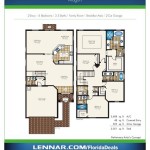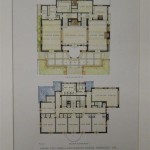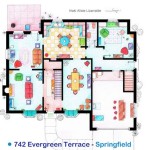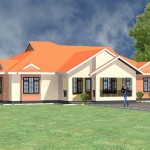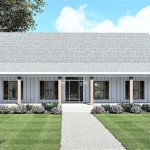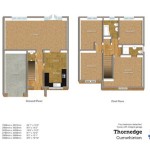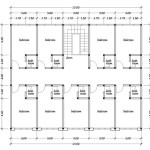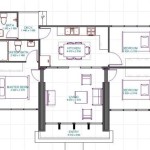Narrow Lot House Plans With 2-Car Garage
Urban living and rising land costs have contributed to the increasing popularity of narrow lot homes. These homes maximize limited space without sacrificing functionality or style. Incorporating a 2-car garage into a narrow lot design presents unique challenges, but careful planning can result in a comfortable and efficient living space. This article explores the key considerations and advantages of narrow lot house plans that accommodate a 2-car garage.
One of the primary advantages of a narrow lot house plan is its affordability. Smaller lots are generally less expensive to purchase than wider lots in comparable locations. This can make homeownership more accessible, especially in desirable urban areas. While building costs per square foot might be slightly higher due to specialized design and construction techniques, the smaller overall footprint often results in lower total construction costs.
Maximizing vertical space is a hallmark of narrow lot house plans. Multiple stories allow for a greater square footage within the limited lot size. This often translates to distinct living zones, with bedrooms typically located on upper levels for increased privacy. Open floor plans on the main level create a sense of spaciousness, while strategically placed windows maximize natural light penetration, counteracting the potential for a cramped feel.
Integrating a 2-car garage into a narrow lot design requires careful consideration. A tandem garage, where cars are parked one behind the other, is a common solution. This configuration minimizes the garage's width, preserving valuable lot space for the house itself. Alternatively, a stacked garage, with one parking space above the other, can be a viable option, though it often involves greater construction complexity and cost.
The placement of the garage is another critical factor. A front-loaded garage, facing the street, is a traditional approach. However, this can dominate the facade and limit design options. A side-loaded garage, accessed from a driveway along the side of the house, is often preferred in narrow lot designs. This placement minimizes the garage's street-facing presence and allows for more creative architectural treatments.
Outdoor living space can be a challenge in narrow lot homes. However, clever design can incorporate small patios, balconies, or rooftop decks to provide areas for relaxation and entertainment. Courtyards, strategically placed within the house's footprint, can offer a private outdoor oasis, shielded from street noise and the view of neighbors.
Architectural styles for narrow lot homes are diverse and can range from traditional to contemporary. Modern designs often feature clean lines and minimalist aesthetics, while traditional styles might incorporate elements such as pitched roofs and decorative trim. The chosen architectural style should complement the surrounding neighborhood while reflecting the homeowner's personal preferences.
Sustainability is an increasingly important consideration in home design. Narrow lot homes can be designed with energy efficiency in mind. Features like high-performance windows, insulated walls, and energy-efficient appliances can minimize energy consumption and reduce utility costs. Smaller homes inherently require less energy to heat and cool, contributing to a smaller environmental footprint.
Privacy can be a concern with narrow lot homes due to their proximity to neighboring properties. Careful window placement and landscaping can mitigate this issue. Frosted glass, strategically placed trees, and privacy fences can create visual barriers while still allowing natural light to enter the home.
Working with an experienced architect specializing in narrow lot designs is crucial. They can navigate the complexities of designing a functional and aesthetically pleasing home within the constraints of a limited lot size. Architects can also assist with navigating local building codes and regulations specific to narrow lot construction.
Exploring different narrow lot house plans with 2-car garages is essential. Online resources, architectural publications, and home design shows can provide inspiration and insights into various design possibilities. Visiting model homes or completed projects can offer a tangible understanding of how space is utilized in narrow lot homes.
Choosing the right narrow lot house plan involves balancing functionality, aesthetics, and budget. Prioritizing needs and wants is crucial. Determining essential features, such as the number of bedrooms and bathrooms, and desired amenities, like a home office or a dedicated laundry room, will guide the selection process.
Construction on a narrow lot presents unique challenges. Access for construction equipment can be limited, requiring careful planning and coordination. Specialized construction techniques may be necessary to build within the confined space. Working with a reputable builder experienced in narrow lot construction is critical for a successful project.
Landscaping plays a vital role in enhancing the curb appeal and overall aesthetic of a narrow lot home. Vertical landscaping, utilizing trellises and climbing plants, can maximize limited space while adding visual interest. Small trees and shrubs can soften the hard lines of the house and create a sense of privacy.

Plan 42823mj Narrow Lot Mediterranean House In 2024 Plans

Narrow Lot Style With 3 Bed 2 Bath Car Garage House Plans Craftsman

2 Story House Plans For Narrow Lots Blog Builderhouseplans Com

Plan 8168 3 Bedroom 2 Bath House With Car Garage Narrow Lot Plans 1 Sto Craftsman Style

Elegant House Plan For Narrow Lot 36419tx Architectural Designs Plans

Plan 46886 Narrow Lot Style With 4 Bed 3 Bath 2 Car Garage

House Plan 46887 Narrow Lot Style With 1826 Sq Ft 3 Bed 2 Bat

20 Luxury Narrow House Plans With Front Garage Images Small Traditional Plan

House Plan 63179 Narrow Lot Style With 1284 Sq Ft 3 Bed 2 Bat

Narrow Lot Traditional With Alley Garages

